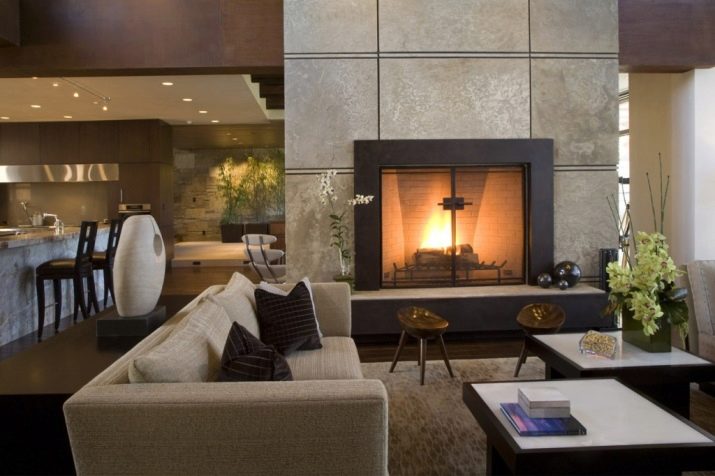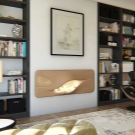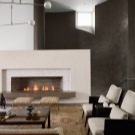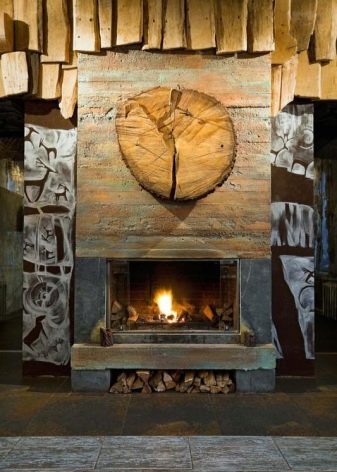Independent installation of a fireplace
So, you had an idea to decorate the interior of your house with a fireplace. After reading this article, you will know all the key points of installation, decoration and operation of this element of decor.
Rules and requirements
In order for the operation of the fireplace to be comfortable and safe, during the installation of the fireplace it is necessary to observe the fire safety regulations and ensure the necessary flow of air, and most importantly, the removal of combustion products (gases, smoke).
This requirement does not depend on which option you plan to implement: an independent display of the fireplace or a ready-made fireplace stove, which you will cover with facing material.
The second option is easier to implement. The manufacturer of ready-made fireplaces in the instructions indicate the installation conditions typical for the type of material from which the house is built, the volume of the room necessary for high-quality and safe work and the location of the chimney.
Installing a fireplace in a wooden house is a multistage and complicated process compared to installing the same unit in a house made of non-combustible materials, since it is necessary to provide an additional distance from the walls to the fireplace, increased attention should be paid to the insulation and tightness of the chimney connecting elements.
Safety is the main criterion when using this type of equipment. If you decide to make installation yourself, entrust the development of the project of the future fireplace to professionals.
Only after a qualified consultation and a well-developed project proceed to the preparatory work, which is carried out in the following order:
- Choosing a place for installation. Depending on the size of the room, select the type of cast-iron firebox, which will serve as the basis for creating a fireplace. Location near the wall is an option suitable for rooms with a large area. The location of the fireplace in the corner of the room is optimal for small rooms (it’s worth remembering that a room of at least 20 m2 is necessary for the safe operation of the firebox).
- Preparation of the base for installation.
- Installation of a finished fireplace or cast-iron firebox, or display of a fireplace stove.
- Installation of smoke exhaust design.
- Fireplace facing works.
- Test run
Materials for installation
To carry out the actions described above, you will need the following materials and tools:
- cement
- fire resistant glue
- mastic
- Master OK
- composite or steel bars
- chimney, if necessary with several "knees", with a diameter of at least 200 mm
- brackets
- construction level
- roulette
- plummet
- Bulgarian with several types of discs for working with various materials (metal, stone or porcelain stoneware)
- perforator or hammer drill
- screwdriver and screwdriver set of different lengths
- insulation materials to reduce chimney heat transfer.
DIY installation
Modern finished products allow you to install a fireplace stove independently in any buildings: in the country, in a townhouse and in a cottage. A rich selection of offers manufacturers of fireplaces and furnaces will allow you to choose a fireplace with an individual design. Your flight of fancy is limited only by the size of the room and financial possibilities.
Determine the purpose of the fireplace.It can perform both decorative and practical tasks - to provide heating for the room, including the attic (fireplace type of heating is widespread in Europe).
Fireplace inserts are of two types: open and closed (cassette). The difference between them is clear from the title, but with the functionality a bit more complicated. For heating the room will suit more closed type. For aesthetic pleasure - open.
Foundation preparation
To install the fireplace, prepare a pedestal on which the stove will be installed later. Without a perfectly flat foundation, the fireplace cannot function normally. The pedestal must be solid and stable. An ideal material for it would be a brick (better fire-resistant), or a cement slab or a marble base.
An important point - the calculation of the load overlaps. If you plan to install a fireplace on the upper floors of the building, make sure that the ceilings will withstand the loads created by the pedestal and the stove. If you install the pedestal on the plank floor, we recommend to make a layer of basalt cotton wool between the floor and the base on which you will install a fireplace in the future.
The next stage is the preparation of the walls. If they are made of flammable materials (covered with wallpaper and other materials), then it is necessary to protect the surface in which zone the stove will be installed. This can be done in several ways:
- lay brickwork
- impose porcelain stoneware or artificial stone, pre-selecting samples with the lowest thermal conductivity. This step is relevant for the wall fireplace.
Firebox
A cast-iron U-shaped plate is laid on a previously prepared pedestal, which is fixed with heat-resistant glue or mastic. The side parts of the plate go deep into the wall (be sure to use the level to estimate the flatness of the surface - this must be done before the glue or the mastic is grabbed and you can make adjustments). As soon as the plate is adjusted in the horizontal plane, you can begin to install the furnace itself. The distance between the back wall of the furnace and the wall should be at least 4-5 cm.
Finish
As soon as the furnace is mounted, we begin to cover it with bricks. The important point is that it is impossible to build a firebox close to the walls of the fireplace - they must be very tightly connected to the supporting wall, and the joints in the joints must be puttied.Brick walls are erected above the firebox, approximately in two bricks, after which the upper U-shaped cast-iron plate is fastened, which is attached to glue or mastic. We proceed to the next stage of work.
Exhaust hood
Chimneys in their performance are of several types: from brick and stainless steel. Let us consider in more detail each of them.
-
Brick. Creates a beautiful picture, but has a number of serious drawbacks. First, the load on the foundation and floors is heavier, which complicates installation on the upper floors and in rooms where an additional safety factor was not provided for in the design. Secondly, it requires additional reinforcement with iron or composite reinforcement and wall fasteners during construction. Thirdly, the service life of such a system is a maximum of 10 years, even with proper and timely care. This is due to the formation of condensate, the need to provide perfectly flat walls, as well as additional insulation. Thus, the already expensive system requires additional costs.
- Galvanized. Pipes for such a system of exhaust smoke and combustion products have a different diameter, length and low weight.This allows you to install a fireplace in almost any room and at any stage of construction facilities. Service life - at least 20 years. Cons: pipes do not retain heat and require additional thermal insulation.
It is important to remember that chimneys are of different types: classic French, for example, does not have a gas threshold, has a simple structure and is less economical than a classic English chimney device.
If desired, you can easily decorate such a chimney, for example, hide it in a box made of non-combustible materials and lay it with tiles or artificial stone.
After the installation of the chimney is completed, you can proceed to facing the walls of the fireplace with ceramic granite or artificial stone, depending on preference and the general concept of interior design.
Functional check
Before the test start of the fireplace, it is necessary to open the windows and ensure a draft, since paint will burn off on the painted parts of the firebox. If the smoke, instead of going into the chimney, knocks into the room, it is necessary to check the flow of air into the furnace and make sure of the tightness of the joints at the joints of the chimney pipes.
Common mistakes and how to avoid them
One of the main mistakes is the lack of a clear distinction between types of equipment, its purpose, technical characteristics and functionality. Prepare in advance a list of examples of what your future fireplace is. Write down the inalienable functions and characteristics that it should have - this will save money and nerves when communicating with company managers. And the further process of operation will be comfortable.
Miscalculations when buying. Fireplace - an expensive project. Do not try to save on trifles, trust the professionals in the selection of equipment, and perform the installation work yourself.
Constructional miscalculations. We talked about them at the very beginning. Even if you decide to develop the project of the fireplace yourself: from the power of the ventilation system of the room to the air supply system to the furnace of the fireplace, it is still strongly recommended to entrust this work to professionals.
Cost of
The average cost of making a fireplace out of bricks with their own hands is about 30,000 rubles. If you involve outside personnel, be prepared for this amount to add at least another 45,000 rubles.On average, the estimate of work will be: 75 000 rubles + the cost of the project, which, as we found out above, is better not to save.
The variant with the finished cast-iron firebox and its installation will cost, on average, 80,000 rubles. The price will depend on the selected model of the furnace. Installation work will cost approximately 45,000 rubles, do not forget to add the cost of the project here.
We recommend to buy cast-iron fireboxes only of proven manufacturers, the furnaces of the following companies are currently the most popular on the Russian market: Chamane, Alpha, Snip, Bullerjan, Solo. These manufacturers provide models that have the ability to install both on a concrete slab and on a ceramic granite base.
Warm and comfortable in your home! And so that all this will certainly come true, approach the choice of the fireplace wisely and with pragmatic calculation.




















































































